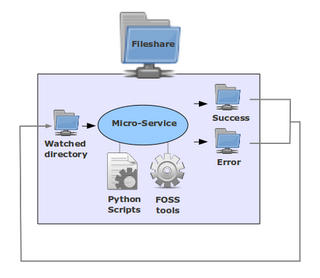Difference between revisions of "Micro-services"
| Line 8: | Line 8: | ||
These information packages are moved from one service to the next using the well-established [http://en.wikipedia.org/wiki/Pipeline_%28Unix%29 Unix pipeline] design pattern. Each micro-service is defined in a simple XML configuration file and associated with a watched directory. When an information package is moved to that directory it triggers the micro-service. | These information packages are moved from one service to the next using the well-established [http://en.wikipedia.org/wiki/Pipeline_%28Unix%29 Unix pipeline] design pattern. Each micro-service is defined in a simple XML configuration file and associated with a watched directory. When an information package is moved to that directory it triggers the micro-service. | ||
| − | Each service is provided by a combination of Archivematica Python scrips and one or more of the free, open-source [[External tools|software tools]] bundled in the Archivematica system. Each micro-service results in a success or error state and the information package is moved accordingly to a success or error directory. Each success or error directory is the watched directory for a subsequent micro-service. This allows for the chaining of directories into complex, custom workflows. Archivematica implements a default ingest to access workflow that is [[Requirements|compliant with the ISO-OAIS]] functional model. | + | Each service is provided by a combination of Archivematica Python scrips and one or more of the free, open-source [[External tools|software tools]] bundled in the Archivematica system. Each micro-service results in a success or error state and the information package is moved accordingly to a success or error directory. Each success or error directory is the watched directory for a subsequent micro-service. This allows for the chaining of directories into complex, custom workflows. Archivematica implements a default ingest to access workflow that is [[Requirements|compliant with the ISO-OAIS]] functional model. |
| − | |||
| − | |||
| − | |||
| − | |||
| − | |||
| − | |||
| − | |||
| − | |||
| − | |||
| − | |||
| − | |||
| − | |||
| − | |||
| − | |||
| − | |||
| − | |||
| − | |||
| − | |||
| − | |||
| − | |||
| − | |||
| − | |||
| − | |||
| − | |||
| − | |||
| − | |||
| − | |||
| − | |||
| − | |||
| − | |||
| − | |||
| − | |||
| − | |||
| − | |||
| − | |||
| − | |||
| − | |||
| − | |||
| − | |||
| − | |||
| − | |||
| − | |||
| − | |||
| − | |||
| − | |||
| − | |||
| − | |||
| − | |||
| − | |||
| − | |||
| − | |||
| − | |||
| − | |||
| − | |||
| − | |||
| − | |||
| − | |||
| − | |||
| − | |||
| − | |||
| − | |||
| − | |||
| − | |||
| − | |||
| − | |||
| − | |||
| − | |||
Revision as of 17:06, 8 August 2011
Main Page > Documentation > Technical Architecture > Micro-services
The Archivematica micro-services are granular system tasks which operate on a conceptual entity that is equivalent to an OAIS information package: Submission Information Package (SIP), Archival Information Package (AIP), Dissemination Information Package (DIP). The physical structure of an information package will include files, checksums, logs, XML metadata, etc..
These information packages are moved from one service to the next using the well-established Unix pipeline design pattern. Each micro-service is defined in a simple XML configuration file and associated with a watched directory. When an information package is moved to that directory it triggers the micro-service.
Each service is provided by a combination of Archivematica Python scrips and one or more of the free, open-source software tools bundled in the Archivematica system. Each micro-service results in a success or error state and the information package is moved accordingly to a success or error directory. Each success or error directory is the watched directory for a subsequent micro-service. This allows for the chaining of directories into complex, custom workflows. Archivematica implements a default ingest to access workflow that is compliant with the ISO-OAIS functional model.
